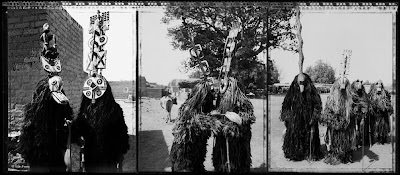 Linda Troeller's "Healing Waters" (Aperture) won 'Pictures of the Year' Book Award for Excellence. Cover, "Floating, Terme di Saturnia, Italy, 1996"
Linda Troeller's "Healing Waters" (Aperture) won 'Pictures of the Year' Book Award for Excellence. Cover, "Floating, Terme di Saturnia, Italy, 1996"Mucalinda: Self-Portrait + Self-Reflection
"Mucalinda was a serpent king that emerged from the earth and protected Buddha with his hood from a storm. The book title is a metaphor of coming to terms with the multiplicity and the convergences of my life, an affirmation of the different moments which are represented in these self-portraits and portraits by other photographers."
"Self-reflection is reassurance for our psyche. French psychoanalyst Jacques Lacan coined the term “the mirror stage,” which refers to early development in which an infant sees his own likeness, watches it move as he feels his body move, and thus realizes for the first time that he is the master of his own corporal form."
"Florence Nightingale, the civil war nurse, wrote that color, form and light provoke a physical effect on well-being. Photographers enter into that realm of light with their eyes and sensation. Photography can connect us to ‘oneness,’ and a ‘source.’ Research shows that photographs are recorded in the frontal lobe of the brain, which control heartbeat, blood flow, and hormones. This optic –unconscious relationship brings us visions of places yet to be discovered, universal, and yet rare. I experienced this kinship with my first camera, a Rollei, at the age of twenty at Ghost Ranch, New Mexico when Georgia O’Keeffe told me, “Let the powers out there guide you.” The impulse to snap the shutter directly links us to mythic absorption which is what the Mexican painter, Leonora Carrington named “down below.” She said if I wanted to heal from a breakup and grow as an artist I would “take the waters in San Jose Purua and Ixtapan or mushrooms in Palenque” to access things internal, archetypal, redeemable. – Linda Troeller, Mucalinda
Linda Troeller Exhibition Curated by Sabine Kutt
Art Basel/Miami Beach Dec 1- 3
Art Basel/Miami Beach Dec 1- 3
 Self-Portrait, Lobby, Chelsea Hotel, NYC, 2006
Self-Portrait, Lobby, Chelsea Hotel, NYC, 2006 "Artist. Model. Author. Muse. Linda Troeller plays many parts in her photographic life. Throughout a prolific career photographing and publishing books on female sexuality, healing-water spas, the AIDS epidemic, and her home in New York’s legendary Chelsea Hotel, Troeller has regularly served as a subject for the camera, her own and those of her colleagues. Mucalinda: Self-Portrait + Self-Reflection, a collection of images by Troeller and other photographers from the 1970s to today, is an intimate, illuminating assessment of one artist’s deep engagement with seeing and understanding herself through the camera’s lens."
"Troeller’s dual roles behind and in front of the camera make her an anomaly in a community where most hide behind their viewfinders. But her exceptional beauty, along with the strength, openness, and willingness to collaborate with other artists on subtle, spiritual levels manifested in each photograph, made it inevitable that she would inspire other photographers as a subject. In each fearless image Troeller depicts the creative arc of a soul in love with photography and life.”–Toby Kamps, Mucalinda
Toby Kamps, Senior Curator, Contemporary Arts Museum Houston, Texas
"Troeller’s dual roles behind and in front of the camera make her an anomaly in a community where most hide behind their viewfinders. But her exceptional beauty, along with the strength, openness, and willingness to collaborate with other artists on subtle, spiritual levels manifested in each photograph, made it inevitable that she would inspire other photographers as a subject. In each fearless image Troeller depicts the creative arc of a soul in love with photography and life.”–Toby Kamps, Mucalinda
Toby Kamps, Senior Curator, Contemporary Arts Museum Houston, Texas
 MUCALINDA: Self-Portraits + Self-Reflection
MUCALINDA: Self-Portraits + Self-Reflectionview and purchase here
Linda Troeller’s vast corpus of self-portraits spanning the length of her artistic career serve as testaments to the many faces that composite the idea of self. The compulsive remaking of her own image through the expanse of time (or timelessness) falls within the artist’s desire to inscribe her likeness on the visual field. It is as if Troeller is making up for the lack of the emancipated female subject in art historical discourse. Her images often elicit a dreamscape, as her body is often pictured in nature, floating in water or suspended in between the horizon line of ground and air. The transcendent quality of Troeller’s self-portraits point to her desire to achieve the liberated female subject in art through the constant re-imaging of her own body within the pictorial frame. – Kalia Brooks, Mucalinda
Kalia Brooks, Adjunct Professor, New York University, Tisch School of the Arts, Photography and Imaging Department, Exhibition Director, Museum of Contemporary African Diasporan Arts (MoCADA)
Linda Troeller will teach "Self-Portraiture and Poetry" with Maureen Alsop in Palm Springs, California, April 2-5, 2012. Many thanks to Linda for allowing me to excerpt from her book, Mucalinda: Self-Portraits + Self-Reflection
Kalia Brooks, Adjunct Professor, New York University, Tisch School of the Arts, Photography and Imaging Department, Exhibition Director, Museum of Contemporary African Diasporan Arts (MoCADA)
+ + +
Upcoming News
Linda Troeller Exhibition Curated by Sabine Kutt
Art Basel/Miami Beach Dec 1- 3
Linda Troeller Exhibition Curated by Sabine Kutt
Art Basel/Miami Beach Dec 1- 3
Exhibition Mucalinda: Self-Portrait + Self-Reflection
Hellenic Centre for Photography, Athens and
Tenerife Photography Festival, Canary Islands, Spain
through the end of 2011
Hellenic Centre for Photography, Athens and
Tenerife Photography Festival, Canary Islands, Spain
through the end of 2011
Linda Troeller will teach "Self-Portraiture and Poetry" with Maureen Alsop in Palm Springs, California, April 2-5, 2012. Many thanks to Linda for allowing me to excerpt from her book, Mucalinda: Self-Portraits + Self-Reflection










































